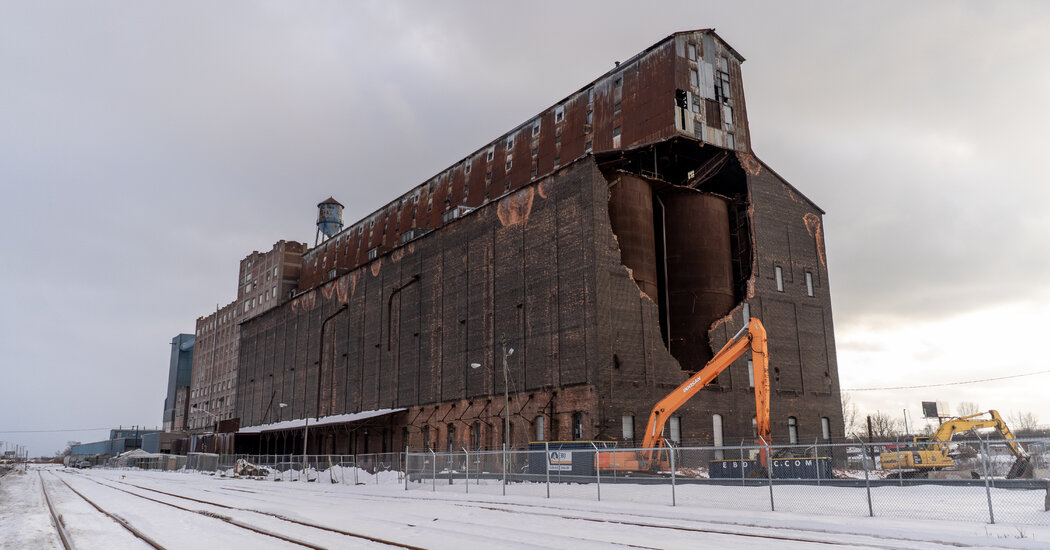The current owner of the Great Northern has been pushing to demolish the building — possibly the last grain elevator of its type in the world.
BUFFALO — At first glance, the hulking brick building on the edge of Lake Erie looks like another decaying relic of Buffalo’s once-prosperous past, an image made all the worse by an enormous gash in its exterior, the victim of this city’s raking winter winds.
But to the trained and loving eye, the building — the Great Northern grain elevator — is a beauty, a testament to ingenious engineering and turn-of-the-century chutzpah, whose utility and aesthetic profoundly influenced generations of architects.
“These were the kind of cathedrals of the modern age,” said Gregory Delaney, a clinical assistant professor at the University at Buffalo’s architecture school, noting the elevator’s unique blend of function and technology. “It’s a building that is at the same scale as a great medieval cathedral, with a similar kind of monumental power.”
So it is with no small amount of consternation for grain-elevator aficionados that the building’s current owner — Archer Daniels Midland Milling Co., part of the farm and food products giant — has been pushing to demolish the Great Northern, setting off a furious fight between preservationists and the company. It has also placed Buffalo’s mayor, Byron Brown, in the unenviable position of either allowing the destruction of a local landmark or defying a valued local employer.
The push to preserve — and potentially restore — the Great Northern is part of a larger movement toward reimagining industrial buildings and areas, from the Brooklyn Navy Yard to the Presidio in San Francisco. That includes museums and other cultural institutions devoted to such seemingly prosaic trades as milling, mining and drilling.
At the same time, the unusual fight over an unglamorous structure also seems particularly apt for Buffalo, a postindustrial city that has long endured a lack of respect but has seen a welcome uptick in population and economic investment over the last decade.
“The grain elevator is what we contributed to architecture on the world stage,” said Jessie Fisher, the executive director of Preservation Buffalo Niagara, a regional preservation nonprofit, noting that such elevators were invented in Buffalo in the 1840s. “And as the European modernists started to see these structures, it really influenced a lot of the avant-garde.”
Archer Daniels insists that the building — which lost a swath of its brick cladding in a December gale — is an imminent danger to public safety and applied for an emergency permit to raze it.
In mid-January, the city approved the permit over the objections of federal and state lawmakers, and local conservationists. But almost immediately, a state appellate judge granted preservationists a temporary restraining order to stop demolition. The judge set a hearing on the matter for this week.
It’s not the first time the Great Northern has faced oblivion; its current owner previously sought permission to demolish it, as had its previous owner, Pillsbury.
Among the grain elevator’s supporters are the Buffalo city council, which recently passed a resolution asking Archer Daniels “to explore the options to collaborate with or sell the property” rather than tear it down.
For his part, Mr. Brown, a fifth-term Democrat who was re-elected in a contentious write-in campaign last fall, said that he was in favor of keeping the grain elevator standing but wasn’t prepared to stop the demolition.
Preservationists have accused Archer Daniels of “demolition by neglect,” essentially leaving the Great Northern to rot and bear the brunt of brutal weather and lack of maintenance. The building — which soars some 15 stories — sits surrounded by a chain-link fence, with broken windows puckering its elongated, and rusted, rooftop cupola.
At least two developers have voiced interest in redeveloping the structure, which sits on a spit of land bordered by the Buffalo River, the snaking east-west river that cuts through a nearby area still known as Elevator Alley, flanked as it is by other towering silos. Ideas for residential-retail developments and arts institutions have been floated by supporters of its preservation, or perhaps a granary museum, a possible complement to silo tours that some companies already offer.
In mid-January, a Washington, D.C., developer who has been active in Buffalo, Douglas Jemal, offered Archer Daniels $100,000 to repair the hole in the building’s northern wall, a proposition that was declined by the company.
Mr. Jemal, whose company has restored other old industrial buildings, including a Wonder Bread factory in Washington, said the Great Northern “should not be knocked down by a wrecking ball.”
“That grain fed the world,” he said. The elevator, he said, has character: “It has a soul, a 125-year-old soul.”
Built in 1897, the Great Northern is considered one of the last — if not the last — “brick-box” grain elevators in the world, with a brick exterior meant to shield dozens of steel silos inside.
Buffalo’s connection with grain goes deep: At one point the city was one of the biggest grain ports in the world, receiving tons of wheat from Midwestern farms via the Great Lakes. Cereal and flour companies blossomed — including General Mills, which still has a large factory near the grain elevator — so much so that locals would joke that the city “smelled like Cheerios.”
During its prime, the Great Northern purred — fueled by electricity generated by Niagara Falls, about 20 miles northwest of Buffalo — as grain was received from rail cars and boats, and then pulled up and into the silos by a series of hoppers and conveyors, essentially turning the entire building into a machine.
Buffalo’s primacy in the grain business faded in the mid-1900s, and the building slowly fell out of use, finally shuttering in 1981. It was recognized as a local landmark in 1990, and Archer Daniels acquired the building in 1992, along with a still-active flour mill next door.
Though it has done repairs, the company says the walls — made up of six million bricks — and foundation are deteriorating fast, and pieces of the metal roof have flown off in the past, almost hitting an employee in December.
Archer Daniels is increasingly concerned that a major collapse could happen at any time, Jackie Anderson, a company spokeswoman, said in a statement.
“We remain committed to finding ways to preserve the legacy of the structure,” she added. “However, safety must be at the forefront of these discussions and decisions.”
Some lawmakers seem skeptical of the company’s intentions, including Representative Brian Higgins, a local Democrat and former instructor at SUNY Buffalo State College who once taught a college course about the economic history of Buffalo. He said he was confident that the city could find a good use for the building.
“Buffalo does historic preservation well, because we were blessed to have a lot of buildings that were worth the effort,” he said, adding that Buffalo had benefited greatly from federal tax credits meant to encourage preservation and redevelopment.
In early January, State Senator Sean Ryan, a Democrat who represents much of Buffalo, held a rally in support of the Great Northern, an event that drew a couple dozen supporters. Among them was Michael Di Pasquale, an assistant professor at the University of Massachusetts Amherst, who drove six hours to the rally to safeguard what he called an “irreplaceable example” of late 19th-century architecture.
Many cities, Mr. Di Pasquale said, are grappling with the conflicting desires to embrace the past and the constant pressure for new development.
“It’s harder to imagine that building being restored to some spectacular public use,” he said, speaking of challenges faced by preservationists in lobbying for reuse of old buildings. “It’s easier to see some suburban office park.”
The area around the Great Northern displays signs of other new commercial activity, including two hockey rinks, a large bar and restaurant, and a climbing wall, affixed to the side of an old silo.
Tyler Miller, a manager at the Wonder Coffeehouse, directly across the street from the grain elevator, said that he had been working the day the brick wall collapsed and emergency vehicles rushed to the scene. He had also said that cafe employees had found metal, blown from the elevator’s rooftop, in the parking lot outside after a storm last year.
Still, he said, he doesn’t want to see the structure come down and hopes “something happens with it.”
“I think it’s a beautiful piece of architecture,” Mr. Miller said. “I couldn’t imagine it being gone.”































